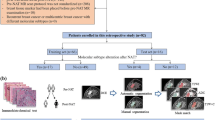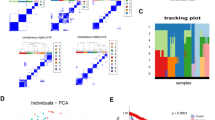Abstract
Objective
The status of isocitrate dehydrogenase 1 (IDH1) is highly correlated with the development, treatment and prognosis of glioma. We explored a noninvasive method to reveal IDH1 status by using a quantitative radiomics approach for grade II glioma.
Methods
A primary cohort consisting of 110 patients pathologically diagnosed with grade II glioma was retrospectively studied. The radiomics method developed in this paper includes image segmentation, high-throughput feature extraction, radiomics sequencing, feature selection and classification. Using the leave-one-out cross-validation (LOOCV) method, the classification result was compared with the real IDH1 situation from Sanger sequencing. Another independent validation cohort containing 30 patients was utilised to further test the method.
Results
A total of 671 high-throughput features were extracted and quantized. 110 features were selected by improved genetic algorithm. In LOOCV, the noninvasive IDH1 status estimation based on the proposed approach presented an estimation accuracy of 0.80, sensitivity of 0.83 and specificity of 0.74. Area under the receiver operating characteristic curve reached 0.86. Further validation on the independent cohort of 30 patients produced similar results.
Conclusions
Radiomics is a potentially useful approach for estimating IDH1 mutation status noninvasively using conventional T2-FLAIR MRI images. The estimation accuracy could potentially be improved by using multiple imaging modalities.
Key Points
• Noninvasive IDH1 status estimation can be obtained with a radiomics approach.
• Automatic and quantitative processes were established for noninvasive biomarker estimation.
• High-throughput MRI features are highly correlated to IDH1 states.
• Area under the ROC curve of the proposed estimation method reached 0.86.






Similar content being viewed by others
References
Patrick YW, Santosh K (2008) Malignant Gliomas in Adults. N Engl J Med. doi:10.1056/NEJMra0708126
Wang Q, Zhang H, Zhang J et al (2016) The diagnostic performance of magnetic resonance spectroscopy in differentiating high-from low-grade gliomas: A systematic review and meta-analysis. Eur Radiol. doi:10.1007/s00330-015-4046-z
Venneti S, Huse JT (2015) The evolving molecular genetics of low-grade glioma. Adv Anat Pathol. doi:10.1097/PAP.0000000000000049
Brat DJ, Verhaak RG, Aldape KD et al (2015) Comprehensive. Integrative Genomic Analysis of Diffuse Lower-Grade Gliomas. N Engl J Med. doi:10.1056/NEJMoa1402121
Weller M, Pfister SM, Wick W, Hegi ME, Reifenberger G, Stupp R (2013) Molecular neuro-oncology in clinical practice: a new horizon. Lancet Oncol. doi:10.1016/S1470-2045(13)70168-2
Beiko J, Suki D, Hess KR et al (2014) IDH1 mutant malignant astrocytomas are more amenable to surgical resection and have a survival benefit associated with maximal surgical resection. Neuro Oncol. doi:10.1093/neuonc/not159
Aerts HJ, Velazquez ER, Leijenaar RT et al (2014) Decoding tumour phenotype by noninvasive imaging using a quantitative radiomics approach. Nat Commun. doi:10.1038/ncomms5006
Gillies RJ, Kinahan PE, Hricak H (2016) Radiomics: Images Are More than Pictures. They Are Data. Radiology. doi:10.1148/radiol.2015151169
Vallières M, Freeman CR, Skamene SR, El Naqa I (2015) A radiomics model from joint FDG-PET and MRI texture features for the prediction of lung metastases in soft-tissue sarcomas of the extremities. Phys Med Biol. doi:10.1088/0031-9155/60/14/5471
Wu W, Parmar C, Grossmann P et al (2016) Exploratory Study to Identify Radiomics Classifiers for Lung Cancer Histology. Front Oncol. doi:10.3389/fonc.2016.00071
Cameron A, Khalvati F, Haider M, Wong A (2015) MAPS: A Quantitative Radiomics Approach for Prostate Cancer Detection. IEEE Trans Biomed Eng. doi:10.1109/TBME.2015.2485779
Wang J, Kato F, Oyama-Manabe N et al (2015) Identifying Triple-Negative Breast Cancer Using Background Parenchymal Enhancement Heterogeneity on Dynamic Contrast-Enhanced MRI: A Pilot Radiomics Study. PLoS One. doi:10.1371/journal.pone.0143308
Parmar C, Grossmann P, Rietveld D, Rietbergen MM, Lambin P, Aerts HJ (2015) Radiomic Machine-Learning Classifiers for Prognostic Biomarkers of Head and Neck Cancer. Front Oncol. doi:10.3389/fonc.2015.00272
Chan AK, Yao Y, Zhang Z et al (2015) TERT promoter mutations contribute to subset prognostication of lower-grade gliomas. Mod Pathol. doi:10.1038/modpathol.2014.94
Pereira S, Pinto A, Alves V, Silva CA (2016) Brain Tumor Segmentation using Convolutional Neural Networks in MRI Images. IEEE Trans Med Imaging. doi:10.1109/TMI.2016.2538465
Wechsler-Reya R, Scott MP (2001) The developmental biology of brain tumors. Annu Rev Neurosci. doi:10.1146/annurev.neuro.24.1.385
Mazziotta J, Toga A, Evans A et al (2001) A probabilistic atlas and reference system for the human brain. International Consortium for Brain Mapping (ICBM). Philos Trans R Soc Lond B Biol Sci. doi:10.1098/rstb.2001.0915
Ellingson BM, Cloughesy TF, Pope WB et al (2012) Anatomic localization of O6-methylguanine DNA methyltransferase (MGMT) promoter methylated and unmethylated tumors: a radiographic study in 358 de novo human glioblastomas. Neuroimage. doi:10.1016/j.neuroimage.2011.09.076
Wang YY, Zhang T, Li SW et al (2015) Mapping p53 mutations in low-grade glioma: a voxel-based neuroimaging analysis. AJNR Am J Neuroradiol. doi:10.3174/ajnr.A4065
Wang Y, Zhang T, Li S et al (2015) Anatomical localization of isocitrate dehydrogenase 1 mutation: a voxel-based radiographic study of 146 low-grade gliomas. Eur J Neurol. doi:10.1111/ene.12578
Tzourio-Mazoyer N, Landeau B, Papathanassiou D et al (2002) Automated anatomical labeling of activations in SPM using a macroscopic anatomical parcellation of the MNI MRI single-subject brain. Neuroimage. doi:10.1006/nimg.2001.0978
Collewet G, Strzelecki M, Mariette F (2004) Influence of MRI acquisition protocols and image intensity normalization methods on texture classification. Magn Reson Imaging. doi:10.1016/j.mri.2003.09.001
Haralick RM, Shanmugam K, Dinstein I (1990) Textural features for image classification. IEEE Trans Syst Man Cybern B Cybern. doi:10.1109/TSMC.1973.4309314
Deb K, Pratap A, Agarwal S, Meyarivan T (2002) A fast and elitist multiobjective genetic algorithm: NSGA-II. IEEE TransEvolutComput. doi:10.1109/4235.996017
Peng H, Long F, Ding C (2005) Feature selection based on mutual information: criteria of max-dependency, max-relevance, and min-redundancy. IEEE Trans Pattern Anal Mach Intell. doi:10.1109/TPAMI.2005.159
Cortes C, Vapnik V (1995) Support-vector networks. Mach Learn. doi:10.1007/BF00994018
Nouretdinov I, Costafreda SG, Gammerman A et al (2011) Machine learning classification with confidence: application of transductive conformal predictors to MRI-based diagnostic and prognostic markers in depression. Neuroimage. doi:10.1016/j.neuroimage.2010.05.023
Schapire RE, Singer Y (1999) Improved Boosting Algorithms Using Confidence-rated Predictions. Mach Learn. doi:10.1145/279943.279960
Maglietta R, Amoroso N, Boccardi M et al (2016) Automated hippocampal segmentation in 3D MRI using random undersampling with boosting algorithm. Pattern Anal Appl. doi:10.1007/s10044-015-0492-0
La Fuente MI, Young RJ, Rubel J et al (2016) Integration of 2-hydroxyglutarate-proton magnetic resonance spectroscopy into clinical practice for disease monitoring in isocitrate dehydrogenase-mutant glioma. Neuro Oncol. doi:10.1093/neuonc/nov307
Lombardi G, Corona G, Bellu L et al (2015) Diagnostic value of plasma and urinary 2-hydroxyglutarate to identify patients with isocitrate dehydrogenase-mutated glioma. Oncologist. doi:10.1634/theoncologist.2014-0266
Pope WB, Prins RM, Albert Thomas M et al (2012) Non-invasive detection of 2-hydroxyglutarate and other metabolites in IDH1 mutant glioma patients using magnetic resonance spectroscopy. J Neurooncol. doi:10.1007/s11060-011-0737-8
Andronesi OC, Rapalino O, Gerstner E et al (2013) Detection of oncogenic IDH1 mutations using magnetic resonance spectroscopy of 2-hydroxyglutarate. J Clin Invest. doi:10.1172/JCI67229
Togao O, Hiwatashi A, Yamashita K et al (2016) Grading diffuse gliomas without intense contrast enhancement by amide proton transfer MR imaging: comparisons with diffusion- and perfusion-weighted imaging. Eur Radiol. doi:10.1007/s00330-016-4328-0
LLee S, Choi SH, Ryoo I et al (2015) Evaluation of the microenvironmental heterogeneity in high-grade gliomas with IDH1/2 gene mutation using histogram analysis of diffusion-weighted imaging and dynamic-susceptibility contrast perfusion imaging. J Neurooncol. doi:10.1007/s11060-014-1614-z
Yamashita K, Hiwatashi A, Togao O et al (2016) MR Imaging-Based Analysis of Glioblastoma Multiforme: Estimation of IDH1 Mutation Status. AJNR Am J Neuroradiol. doi:10.3174/ajnr.A4491
Acknowledgements
The scientific guarantors of this publication are Jinhua Yu and Zhifeng Shi. The authors of this manuscript declare no relationships with any companies whose products or services may be related to the subject matter of the article. This work is supported by the National Basic Research Program of China (2015CB755500). Jinhua Yu and Zhifeng Shi have significant statistical expertise. Institutional Review Board approval was obtained. Written informed consent was obtained from all patients in this study. No study subjects or cohorts have been previously reported. Methodology: retrospective, diagnostic study, performed at one institution.
Author information
Authors and Affiliations
Corresponding authors
Additional information
Jinhua Yu and Zhifeng Shi contributed equally to this paper.
Appendices
Appendix 1
A genetic algorithm (GA) usually starts with a population of chromosomes each of which represents a candidate solution to optimising a problem. The fitness of each chromosome is evaluated through an objective function. In following an optimisation procedure, a stronger chromosome has a higher probability of being selected. Selected chromosomes are subjected to crossover and mutation. Crossover and mutation are performed by exchanging portions of chromosomes and changing parts of the chromosome string, respectively. When the selection, crossover and mutation are iterated at certain times, the fittest chromosome is chosen to solve the current optimisation problem.
In the original GA, the fitness of a chromosome is evaluated by the accuracy of the classification, which can be set out as:
where c represents a chromosome. The fitness evaluation in (10) does not take the mutual relationship between chromosomes into consideration, which leads to a relatively narrower selection space and higher dimensions of the selected feature space. A new objective function is therefore used to evaluate the fitness of a chromosome:
where Rank(c) represents the sum of mRMR [25] order number.
Appendix 2
If true positive, true negative, false positive and false negative are represented by TP, TN, FP and FN, respectively, accuracy (ACC), sensitivity (SENS), specificity (SPEC), positive predictive value (PPV), negative predictive value (NPV) and Matthew’s correlation coefficient (MCC) can be calculated as follows:
For an improved GA method, the population size is set as 50, generation number at 30, crossover probability at 0.9 and mutation probability at 0.1.
Appendix 3
Table 6
Table 7
Rights and permissions
About this article
Cite this article
Yu, J., Shi, Z., Lian, Y. et al. Noninvasive IDH1 mutation estimation based on a quantitative radiomics approach for grade II glioma. Eur Radiol 27, 3509–3522 (2017). https://doi.org/10.1007/s00330-016-4653-3
Received:
Revised:
Accepted:
Published:
Issue Date:
DOI: https://doi.org/10.1007/s00330-016-4653-3




